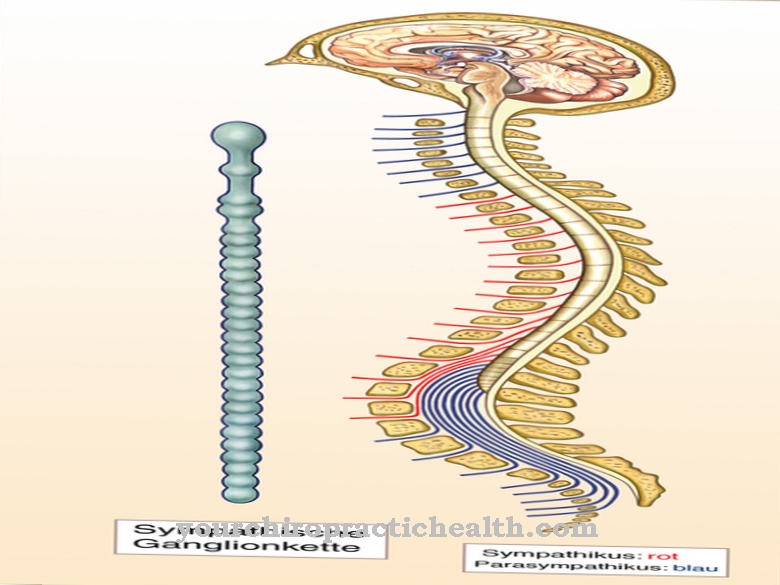In this country, hormone-related diseases such as diabetes, rheumatism or thyroid dysfunction are widespread. These are part of the endocrinologist's range of treatments. However, if neurological or psychiatric disorders occur, the diagnosis and treatment of these diseases are among the tasks of the Neuroendocrinology.
What is Neuroendocrinology?

Neuroendocrinology deals with research as well as with the diagnosis and treatment of neuroendocrine diseases. As a branch of endocrinology, neuroendocrine science is dedicated to the interaction between the nervous and endocrine systems. On the one hand, it is investigated what effect the central nervous system has on hormonal processes. On the other hand, it is about the extent to which the hormones circulating in the blood influence the activity of nerve cells.
The central interface between the nervous system and the hormonal system is located in the human brain. These are called the hypothalamus and pituitary gland and are responsible for regulating important body functions. For example, they control metabolic processes, food intake, reproduction and breastfeeding. The function of the thyroid and the adrenal glands are also controlled by the hypothalamus and pituitary gland. Diseases of neuroendocrine origin cause diverse and unspecific symptoms, so that in many cases they can only be diagnosed after many years.
Treatments & therapies
The main subject of neuroendocrine research are hormones, especially peptide hormones. These function in the body not only as messenger substances, but also as neurotransmitters in signal transmission within the central nervous system.
A disruption in the hormone-producing cells and tissues can cause various clinical pictures. Thousands of patients suffering from hormonal and metabolic diseases are treated every year. The neuroendocrine diseases are divided into several categories:
- Diseases of the hypothalamic-pituitary axis,
- Diseases of the peripheral glands,
- Metabolic disorders,
- Sexual development disorders.
Pituitary dysfunction can result in either pituitary insufficiency or even a pituitary tumor. The pathogenesis and therapy of pituitary tumors are currently the focus of research in neuroendocrine research. By revealing the interactive mechanisms in pituitary tumors, immunosuppressive therapy methods can be developed. In addition, research into metabolic disorders plays an essential role in the development of antidepressant treatment methods, as a change in metabolism is often observed in depressed patients.
Quality of life is severely impaired in patients with active pituitary adenomas. This can lead to sleep disorders or increased pain. An improvement only occurs after successful treatment of the hormone excess. The gender reassignment hormone treatment for transsexuals is also part of the treatment spectrum of neuroendocrinology. Hormone therapy is also an option if a patient has hormone insufficiency. This is the case after a traumatic brain injury or subarachnoid hemorrhage, for example. Overall, the main research areas and the range of treatments in this sub-area are very broad.
Diagnosis & examination methods
There are various examination methods for diagnosing neuroendocrine disease. Which method is the most suitable depends entirely on the complaints and symptoms. For example, with the help of an ultrasound device, non-invasive examinations can be carried out that are also not exposed to radiation.
Sonography shows a morphological picture of organs such as the thyroid, testes and liver. The doctor can use this to determine whether the tissue of an organ is abnormal. A bone density measurement using DXA provides information about whether a person's bone density is reduced. As a rule, the bone tissue is constantly being broken down and newly formed. In the case of an endocrinological disease, however, this process is disturbed, so that the degraded bone tissue cannot be regenerated quickly enough. This disorder occurs in women after the menopause. With the help of magnetic fields and radio waves, the internal tissue structures can be imaged via MRI, in which a computer creates a sectional image of the body.
With this method, every small change in the body can be detected, even if a pituitary adenoma is suspected. The method used to display the electrical activity of the heart is called an EKG. This is derived and recorded as curves. The doctor can use the curves to see whether the heart rhythm and heart rate are abnormal. If any of the curves deviate from the norm, there may be a disease or an overdose of certain drugs. With the UKG (echocardiography), on the other hand, it is not the heart activities but the anatomical structures of the heart that are mapped. This method is safe for the patient because it is performed sonographically.
In this way, the heart muscles and valves can be displayed and their function assessed. A measurement of the body composition comes into question, for example, when weight reduction is required as a therapeutic measure. This method can be used to calculate the distribution of adipose tissue in the body. For example, the ratio of waist and hip circumference is determined. Another method for measuring body composition is bioelectrical impedance analysis (BIA). A weak measuring current is sent through the body via two electrodes in order to measure the body fat percentage, the muscle mass and the water percentage.
Because with some metabolic diseases such as diabetes, the diet should be changed. Many neuroendocrinological outpatient clinics also offer their patients nutritional and diabetes advice in order to support them in increasing their quality of life and reducing symptoms. In this method, the patient's eating habits are analyzed first. Then an individual nutrition plan is created that is tailored to the needs of the patient. A basal metabolic rate measurement is often used to create the diet plan. Because under the influence of certain drugs or diseases, the individual basal metabolic rate can also be changed.
















.jpg)
.jpg)



.jpg)






